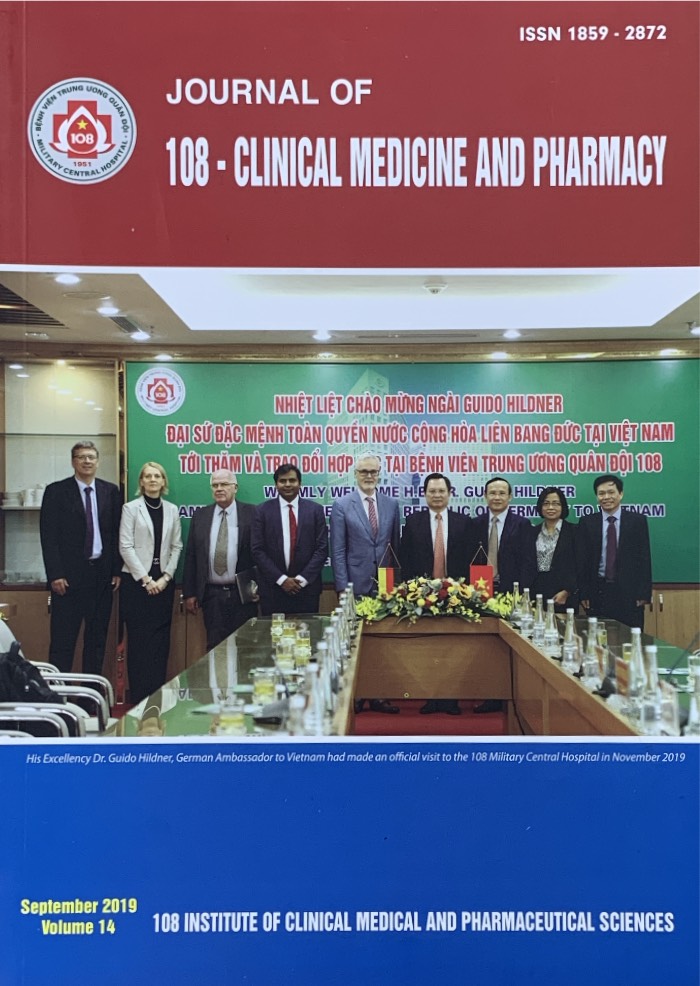Comparison dose distribution between 3D-CRT, IMRT and VMAT techniques in stereotactic body radiation therapy for hepatocellular carcinoma
Main Article Content
Keywords
Tóm tắt
Objective: To compare the difference of dose distribution and physical characteristics on treatment plans using three-dimensional conformal radiation therapy (3D-CRT), intensity modulated radiation therapy (IMRT) and volumetric modulated arc therapy (VMAT) coplanar (CP) and non-coplanar (NCP) techniques in the treatment of hepatocellular carcinoma (HCC) using stereotactic body radiation therapy (SBRT). Subject and method: Twenty HCC patients who previously underwent with SBRT using VMAT on TrueBeam STx linear accelerator were selected. Average CT obtained from 4 Dimension Computed Tomography Simulation (4D-CT) of patients were used to plan on Eclipse v13.6 by 3D-CRT, IMRT, and VMAT (CP and NCP) techniques. The prescription dose of 30 - 60Gy in 3 - 5 fractions was delivered for the planning target volume (PTV). Internal tumor volume (ITV) on average CT was determined by the sum of GTV contoured on ten phases of 4D-CT. The Organ at Risks (OARs) were contoured in average CT. All plans were optimized and evaluated based on the criteria in RTOG 1112. The dose distribution of OARs in DVH (dose volume histogram) and the targets at conformity index (CI), gradient index (GI), homogeneity index (HI), monitor unit (MU) were used to comparing between conformal and modulated techniques. Result: Using VMAT and IMRT, the volume conformity was better than 3D-CRT (p<0.01), reduced significant high dose at liver normal volume. However, 3D-CRT had much lower MU number than VMAT and IMRT techniques. There were no significant differences in OARs such as the heart, esophagus, spinal cord +5mm, chest wall, duodenum. Conclusion: VMAT improves the treatment volume coverage and significantly reduces the dose to the liver normal volume than 3D-CRT and IMRT techniques.
Article Details
Các tài liệu tham khảo
2. Bray F, Ferlay J, Soerjomataram I, and AJ Rebecca L, Lindsey A (2018) Global cancer statistics 2018: GLOBOCAN estimates of incidence and mortality worldwide for 36 cancers in 185 countries. CA Cancer J. Clin 68: 394-424.
3. Jordi Bruix MS, Maria Reig (2015) Evidence-based diagnosis, staging, and treatment of patients with hepatocellular carcinoma. Gastroenterology 150(4): 835-853.
4. Doi H, Beppu N, Kitajima K, and Kuribayashi K, Stereotactic body radiation therapy for liver tumors: Current status and perspectives. Anticancer Res 599: 591-599.
5. Macià M, Garau I (2017) Radiobiology of stereotactic body radiation therapy (SBRT). Reports Pract. Oncol. Radiother 22(2): 86-95.
6. De Baere T et al (2017) The role of image-guided therapy in the management of colorectal cancer metastatic disease. Eur. J. Cancer 75: 231-242.
7. Nosher JL et al (2015) Non-operative therapies for colorectal liver metastases. Rectal Cancer-current Ther. Emerg. Concepts 6(2): 224-240.
8. Me A et al (2006) Stereotactic body radiation therapy for primary and metastatic liver tumors: A single institution phase I-II study. Acta Oncol 45: 831-837.
9. Liang SX et al (2005) Hypofractionated three-dimensional conformal radiation therapy for primary liver carcinoma. Cancer 103(10): 2181-2188.
10. Bae SH, Jang WIl, and Park HC (2017) Intensity-modulated radiotherapy for hepatocellular carcinoma: Dosimetric and clinical results. Oncotarget 8(35): 59965-59976.
11. Woods K et al (2016) Viability of Noncoplanar VMAT for liver SBRT compared with coplanar VMAT and beam orientation optimized 4 p IMRT. Adv. Radiat. Oncol 1(1): 67-75.
12. E Shaw et al (1993) Radiation therapy oncology group: Radiosurgery quality assurance guidelines. Int. J. Radiat. Oncol 27(5): 1231-1239.
13. Paddick I and Lippitz B (2006) A simple dose gradient measurement tool to complement the conformity index. J. Neurosurg 105: 194-201.
 ISSN: 1859 - 2872
ISSN: 1859 - 2872
